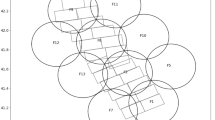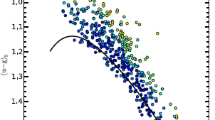Abstract
We propose a set of eleven faint UV white dwarf stars as potential UV standards for the UVIT filter system on-board AstroSat mission. Synthetic photometry of these stars has been carried out using the in-orbit filter curves of UVIT, GALEX, UVOT and model spectra in the literature. The synthetic photometry of GALEX and UVOT is well correlated with their respective observations. The synthetic UVIT photometry is found to be strongly correlated with that of GALEX. The UV extinction \(A_\lambda \) for these stars has been computed using CCM-89 extinction model and its value for the \(\lambda _{\mathrm{mean}}\) of each UVIT filter band has been listed. These results motivate us to recommend this set of stars as additional UVIT flux calibrators.




Similar content being viewed by others
Notes
See www.stsci.edu and MAST
idlastro.gsfc.nasa.gov
References
Bertelli G. et al. 1994, Astron. Astrophys. Suppl. Ser., 106, 275
Bhargavi S. G., Pati A. K. 2009, Poster presented at the ASI meeting held in Indian Institute of Astrophysics, Bangalore, March 2009
Cardelli J. A., Clayton G. C., Mathis J. S. 1989, ApJ, 345, 245.
Pickles A. 1998, PASP, 110, 863
Press W. H. et al. 1992, in Numerical Recipes in Fortran, second edition, Cambridge University Press, Cambridge
Rahna P. T. 2017, MNRAS 471, 3028
Rao N. K. et al. 2018a, A&A, 620, 138
Rao N. K. et al. 2018b, A&A, 609L, 1
Rao N. K. et al. 2020, PASP, 132, 4201
Siegel M. H. et al. 2010, Astronom. J., 725, 1215
Subramaniam A. et al. 2016, ApJ, 833, 27
Subramaniam A. et al. 2017, AJ, 154, 233
Tandon S. N. et al. 2017a, J. Astrophys. Astr., 38, 28
Tandon S. N. et al. 2017b, Astron. J., 154, 128
Tandon S. N. et al. 2020, AJ, 159, 158
Acknowledgements
This work has made use of MAST, SIMBAD and vizier data bases. IDL graphic package and Fortran 77 are used to write own codes. The work presented here is carried out at home without any institutional support. The software programs used here are advanced versions of preliminary programs developed during the tenure at Indian Institute of Astrophysics (IIA), Bangalore. I wish to acknowledge that the investigations presented here basically began from the initial discussions with Professor A. K. Pati (IIA) to compile ‘An All-Sky catalog of secondary standards for UVIT’ and then were developed further. The UVIT is built in collaboration between IIA, IUCAA, TIFR, ISRO and CSA. This publication uses the data from the AstroSat mission of the Indian Space Research Organisation (ISRO), archived at the Indian Space Science Data Centre (ISSDC).
Author information
Authors and Affiliations
Corresponding author
Additional information
This article is part of the Special Issue on “AstroSat: Five Years in Orbit”.
Appendix
Rights and permissions
About this article
Cite this article
Bhargavi, S.G. Potential UV standards for UVIT filter system. J Astrophys Astron 42, 88 (2021). https://doi.org/10.1007/s12036-021-09705-7
Received:
Accepted:
Published:
DOI: https://doi.org/10.1007/s12036-021-09705-7




